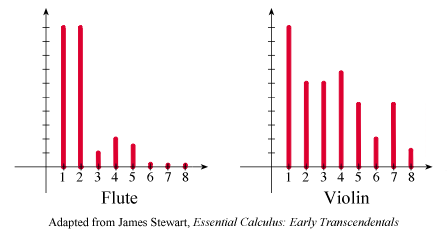Harmonic Series
Every tone (sustained pitch) is actually a composite of several different pitches. These 'extra' pitches, called overtones, are resonant frequencies occurring above the main pitch, called the fundamental. Most overtones are harmonics, which are simple fractional vibrations of the fundamental pitch ( , , , and so on). Since dividing a string in half causes it to vibrate twice as fast, the frequencies of harmonics can found by multiplying the frequency of the fundamental pitch by 2, 3, 4, and so on.
| Harmonic Number ( ) | Frequency in Hz | Pitch Name | Ratio from Previous Harmonic ( ) | Interval from Previous Harmonic |
| 1 (fundamental) | 110 | A | unison | |
| 2 | 220 | A | octave | |
| 3 | 330 | E | perfect fifth | |
| 4 | 440 | A | perfect fourth | |
| 5 | 550 | C♯ | major third | |
| 6 | 660 | E | minor third | |
| 7 | 770 | almost G | small minor third | |
| 8 | 880 | A | large major second |
Audio examples are triangle waveforms downloaded from OnlineToneGenerator.com.
Note that the first three intervals created by successive pitches in the harmonic series are an octave, a perfect fifth, and a perfect fourth. Because of this relationship, these intervals sound particularly consonant and are called the 'perfect' intervals. The later harmonics create intervals that are gradually smaller (thirds, then seconds) and more and more dissonant.
These simple ratios became the basis of several different tuning systems, which are ways to determine the precise frequencies of named pitches.
Timbre and the Harmonic Series
The harmonic series affects timbre because each type of instrument produces a distinctive pattern of loud and soft overtones. As we move farther from the fundamental pitch, overtones have a tendency to become more quiet, but on some instruments particular overtones are more or less powerful than this tendency suggests. The graphs below are frequency power spectrums that show the strengths of the first eight harmonics of a D (294 Hz) at the same volume on a flute and on a violin.

strengths of the first eight harmonics on a flute and a violin
(frequency power spectrums of D at 294 Hz)
The first two harmonics on the flute are very strong, but the remaining harmonics are quite weak. This is what gives the flute its characteristic pure timbre. On the violin, the second harmonic is much weaker than the flute's second harmonic, but the 3rd through 8th harmonics are much stronger than the flute's. This pattern makes the timbre of the violin sound much more complex and rich than that of the flute.

